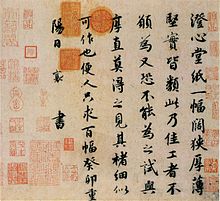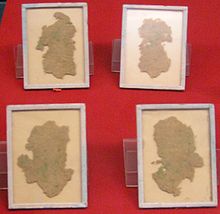China paper
China paper ( Chinese 中國紙 / 中国纸 , Pinyin zhōngguózhǐ ) is a particularly soft, absorbent, usually slightly yellowish paper mainly for engravings , in particular for etchings is used.
The paper used for ink painting is called Xuan paper in China. What is important is its absorbency, which requires precise brushwork and extreme concentration when working. The best qualities have a very low weight of less than 50 g / m 2 , they are available in large sheets up to approx. 200 cm × 600 cm.
China paper plays & a. play a major role in the restoration of books and documents. It is often mistakenly called rice paper .
history
The actual Chinese paper consisted of the bast of the paper mulberry tree as well as ramie , hemp , rice and wheat straw , as well as bamboo ( types of sweet grass ) and rag ; flax , jute Corchorus capsularis , rattan and reed , as well as algae (seaweed, seagrass) were also added. In a special period, boiled bark and flower extract , the Xue-Tao paper , were also made from almond-pork Hibiscus mutabilis . The pulp of Pteroceltis tatarinowii is used for Xuan paper .

In the various Chinese imperial dynasties , the preferred composition changed over time. China paper has not achieved great importance in Europe.
See also: history of paper
The Baqiao paper, discovered in August 1957 in an old grave in a suburb of Xi'an , is the oldest fiber paper in the world. It is a vegetable fiber paper , which consists mainly of hemp and ramie fibers , it dates from about 140-87 BC. Chr.
Historically, many types of Chinese paper are known, e.g. B. from the Tang period : Chengxintang paper (Clear Heart House Paper) it was made for imperial use. The surface is polished and waxed, this paper was still made under the Song , Shuiwen (Yahua) paper with watermarks , Xue Tao paper , a red colored paper, it was invented by the poet Xue Tao . From the Song period: Xiegong paper (10 colored paper), Jinsu paper (Golden Grain Paper), stiff, yellow paper, it was named after the Jinsu monastery in Haiyan ( Jiangsu ) .
See also
- Hanji Korea paper
- Japanese paper
- Rice paper
- Ladle
Web links
literature
- Su Yijian: Wenfang Sipu. 986, Treatise on the Four Treasures of the Study .
- Fei Zhu: Shu Jian Pu. 1324, Handbook on Shichuan Paper.
- Song Yingxing: Tiangong Kaiwu. 1637, German edition, Konrad Herrmann: Opening up the heavenly treasures. Economic development NW, 2004. ISBN 978-3-86509-133-8 .
Individual evidence
- ↑ Andreas Kalweit, Christof Paul, Sascha Peters, Reiner Wallbaum: Handbook for Technical Product Design: 2nd edition, Springer, 2012, ISBN 978-3-642-02641-6 , p. 218.
- Jump up ↑ Joseph Needham : Science and Civilization in China: Vol. 5 Chemistry and chemical technology , Cambridge University Press, 1985, ISBN 0-521-08690-6 , pp. 1–123.
- ^ Lisa Carducci: As Great as the World. China Intercontinental Press, 2002, ISBN 978-7-508-50096-6 , p. 74.
- ↑ Florence Temko: Paper Pandas and Jumping Frogs. China Books & Periodicals, 1986, ISBN 0-8351-1770-7 , p. 121.
- ^ Yongxiang Lu: A History of Chinese Science and Technology, Volume 2, Springer, 2015, ISBN 978-3-66244165-7 , p. 176.
- ↑ Anje Richter: A History of Chinese Letters and Epistolary Culture. Brill, 2015, ISBN 978-90-04-29175-1 , pp. 101 f.
- ↑ Thomas O. Höllmann: The Chinese writing: history, characters, calligraphy. CH Beck, 2015, ISBN 978-3-406-68290-2 .
- ↑ Jiang Wu, Lucille Chia: Spreading Buddha's Word in East Asia: Columbia University Press, 2015, ISBN 978-0-23117160-1 , p. 33.
